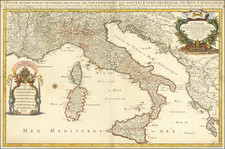Nice old color example of Braun & Hogenberg's view of Novara in the Duchy of Milan, from Braun & Hogenberg's Civitatus Orbis Terrarum.
This bird's-eye view from the east shows the narrowly enclosed city in a densely populated landscape, with Pavia (B) and Milan (A) shown in the background. Parts of the city wall has been damaged and the moat has been dug but not completed - a reference to the armed conflicts in which the city was involved at the beginning of the 16th century, when King Louis XII of France claimed Milan from Duke Ludovica Sforza and laid siege to Novara. Swiss troops helped the duke to victory in 1513. Clearly visible in the castle, originally a Roman fortress that was rebuilt under Duke Galeazzo Maria Sforza in 1468. In the 7th century the Roman city was the centre of a Lombardian duchy and in the 9th century of a French county. In 1167 it joined the Lombard League, and accepted the protection of Milan at the end of the 12th century.
Georg Braun (1541-1622) was born and died in Cologne. His primary vocation was as Catholic cleric; he spent thirty-seven years as canon and dean at the church St. Maria ad Gradus, in Cologne. Braun was the chief editor of the Civitates orbis terrarum, the greatest book of town views ever published. His job entailed hiring artists, acquiring source material for the maps and views, and writing the text. In this role, he was assisted by Abraham Ortelius. Braun lived into his 80s, and he was the only member of the original team to witness the publication of the sixth volume in 1617.
Frans Hogenberg (ca. 1540-ca. 1590) was a Flemish and German engraver and mapmaker who also painted. He was born in Mechelen, south of Antwerp, the son of wood engraver and etcher Nicolas Hogenberg. Together with his father, brother (Remigius), uncle, and cousins, Frans was one member of a prominent artistic family in the Netherlands.
During the 1550s, Frans worked in Antwerp with the famous mapmaker Abraham Ortelius. There, he engraved the maps for Ortelius’ groundbreaking first atlas, published in Antwerp in 1570, along with Johannes van Deotecum and Ambrosius and Ferdinand Arsenius. It is suspected he engraved the title page as well. Later, Ortelius supported Hogenberg with information for a different project, the Civitates orbis terrarium (edited by Georg Braun, engraved by Hogenberg, published in six volumes, Cologne, 1572-1617). Hogenberg engraved the majority of the work’s 546 prospects and views.
It is possible that Frans spent some time in England while fleeing from religious persecution, but he was living and working in Cologne by 1580. That is the city where he died around 1590. In addition to his maps, he is known for his historical allegories and portraits. His brother, Remigius, also went on to some fame as an engraver, and he died around the same time as his brother.









![Descriptio totius Italiae [bound with:] Rerum Moscoviticarum commentarij ... quibus Russiae ac Metropolis eius Moscoviae descriptio, Chorographicae tabulae, Religionis indicatio, Modus excipiendi & tractandi oratores, Itineraria in Moscoviam duo, & alia quaedam continentur](https://storage.googleapis.com/raremaps/img/small/93228.jpg)
![[Vesuvius] Pâtes alimentaires au Vésuve](https://storage.googleapis.com/raremaps/img/small/89595.jpg)

![Europae Tabula VII [Sicily, Malta, Sardinia]](https://storage.googleapis.com/raremaps/img/small/89779.jpg)
![[Heighten with Gold] Paskaerte Van't Westelyckste der Middelandsche Zee.](https://storage.googleapis.com/raremaps/img/small/83768.jpg)
![[ Atlas of Italy ] Topographia Italiae, das ist: Warhaffte und curiöse Beschreibung von gantz Italien. Darinnen nach historischer Warheit, die berühmtesten Städte, Vestungen, Marckflecken und andere Oerter, sampt ihren Antiquitäten](https://storage.googleapis.com/raremaps/img/small/102001.jpg)